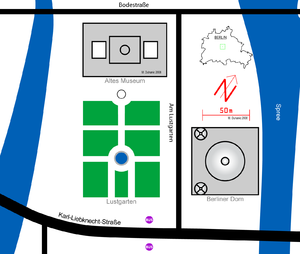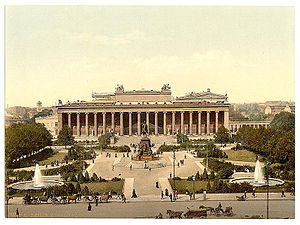
Lustgarten
Encyclopedia


Museum Island
Museum Island is the name of the northern half of an island in the Spree river in the central Mitte district of Berlin, Germany, the site of the old city of Cölln...
in central Berlin
Berlin
Berlin is the capital city of Germany and is one of the 16 states of Germany. With a population of 3.45 million people, Berlin is Germany's largest city. It is the second most populous city proper and the seventh most populous urban area in the European Union...
, near the site of the former Berliner Stadtschloss
Berliner Stadtschloss
The Stadtschloss , was a royal palace in the centre of Berlin, capital of Germany. The palace bore features of the Baroque style, and its shape, finalized by the mid 18th century, is attributed to Andreas Schlüter, whose first design is likely to date from 1702, though the palace incorporated...
(Berlin City Palace) of which it was originally a part. At various times in its history, the park has been used as a parade ground, a place for mass rallies and a public park.
The area of the Lustgarten was originally developed in the 16th century as a kitchen garden attached to the Palace, then the residence of the Elector of Brandenburg, the core of the later Kingdom of Prussia
Kingdom of Prussia
The Kingdom of Prussia was a German kingdom from 1701 to 1918. Until the defeat of Germany in World War I, it comprised almost two-thirds of the area of the German Empire...
. After the devastation of Germany during the Thirty Years War,
Berlin was redeveloped by Friedrich Wilhelm
Frederick William, Elector of Brandenburg
|align=right|Frederick William was Elector of Brandenburg and Duke of Prussia – and thus ruler of Brandenburg-Prussia – from 1640 until his death. A member of the House of Hohenzollern, he is popularly known as the "Great Elector" because of his military and political prowess...
(the Great Elector) and his Dutch wife, Luise Henriette of Nassau. It was Luise, with the assistance of a military engineer Johann Mauritz and a landscape gardener Michael Hanff, who, in 1646, converted the former kitchen garden into a formal garden, with fountains and geometric paths, and gave it its current name.
In 1713, Friedrich Wilhelm I
Frederick William I of Prussia
Frederick William I of the House of Hohenzollern, was the King in Prussia and Elector of Brandenburg from 1713 until his death...
became King of Prussia and set about converting Prussia into a militarised state. He ripped out his grandmother's garden and converted the Lustgarten into a sand-covered parade ground: Pariser Platz
Pariser Platz
Pariser Platz is a square in the centre of Berlin, Germany, situated by the Brandenburg Gate at the end of the Unter den Linden. The square is named after the French capital Paris in honour of the Allied occupation of Paris in 1814, and is one of the main focal points of the city.-History :Pariser...
near the Brandenburg Gate
Brandenburg Gate
The Brandenburg Gate is a former city gate and one of the most well-known landmarks of Berlin and Germany. It is located west of the city centre at the junction of Unter den Linden and Ebertstraße, immediately west of the Pariser Platz. It is the only remaining gate of a series through which...
and Leipziger Platz
Leipziger Platz
Leipziger Platz is an octagonal square in the center of Berlin. It is located along Leipziger Straße just east of and adjacent to the Potsdamer Platz...
were also laid out as parade grounds at this time. In 1790, Friedrich Wilhelm II
Frederick William II of Prussia
Frederick William II was the King of Prussia, reigning from 1786 until his death. He was in personal union the Prince-Elector of Brandenburg and the sovereign prince of the Principality of Neuchâtel.-Early life:...
allowed the Lustgarten to be turned back into a park, but during French occupation of Berlin in 1806 Napoleon
Napoleon I of France
Napoleon Bonaparte was a French military and political leader during the latter stages of the French Revolution.As Napoleon I, he was Emperor of the French from 1804 to 1815...
again drilled troops there.
In the early 19th century, the enlarged and increasingly wealthy Kingdom of Prussia undertook major redevelopments of central Berlin. A large, new classical building, the Old Museum
Altes Museum
The Altes Museum , is one of several internationally renowned museums on Museum Island in Berlin, Germany. Since restoration work in 1966, it houses the Antikensammlung of the Berlin State Museums...
, was built at the north-western end of the Lustgarten by the leading architect, Karl Friedrich Schinkel
Karl Friedrich Schinkel
Karl Friedrich Schinkel was a Prussian architect, city planner, and painter who also designed furniture and stage sets. Schinkel was one of the most prominent architects of Germany and designed both neoclassical and neogothic buildings.-Biography:Schinkel was born in Neuruppin, Margraviate of...
, and between 1826 and 1829 the Lustgarten was redesigned by Peter Joseph Lenné
Peter Joseph Lenné
Peter Joseph Lenné was a Prussian gardener and landscape architect from Bonn who worked in the German classicist style.-Childhood and development:...
, with formal paths dividing the park into six sectors. A 13-metre high fountain in the centre, operated by a steam engine, was one of the marvels of the age. Between 1894 and 1905, the old Protestant church on the northern side of the park was replaced by a much larger building, the Berlin Cathedral (in German, "Berliner Dom"), designed by Julius Carl Raschdorff. In 1871, the fountain was replaced by a large equestrian statue of Friedrich Wilhelm III
Frederick William III of Prussia
Frederick William III was king of Prussia from 1797 to 1840. He was in personal union the sovereign prince of the Principality of Neuchâtel .-Early life:...
.
During the years of the Weimar Republic
Weimar Republic
The Weimar Republic is the name given by historians to the parliamentary republic established in 1919 in Germany to replace the imperial form of government...
, the Lustgarten was frequently used for political demonstrations. The Socialists and Communists
Communist Party of Germany
The Communist Party of Germany was a major political party in Germany between 1918 and 1933, and a minor party in West Germany in the postwar period until it was banned in 1956...
held frequent rallies there. In August 1921, 500,000 people demonstrated against right-wing extremist violence. After the murder of Foreign Minister Walther Rathenau
Walther Rathenau
Walther Rathenau was a German Jewish industrialist, politician, writer, and statesman who served as Foreign Minister of Germany during the Weimar Republic...
in June 1922, 250,000 protested in the Lustgarten. In February, 1933, 200,000 people demonstrated against the new Nazi Party regime of Adolf Hitler
Adolf Hitler
Adolf Hitler was an Austrian-born German politician and the leader of the National Socialist German Workers Party , commonly referred to as the Nazi Party). He was Chancellor of Germany from 1933 to 1945, and head of state from 1934 to 1945...
: shortly afterwards public opposition to the regime was banned. Under the Nazis, the Lustgarten was converted into a site for mass rallies. In 1934, it was paved over and the equestrian statue removed. Hitler addressed mass rallies of up to a million people there.
By the end of World War II
World War II
World War II, or the Second World War , was a global conflict lasting from 1939 to 1945, involving most of the world's nations—including all of the great powers—eventually forming two opposing military alliances: the Allies and the Axis...
in 1945, the Lustgarten was a bomb-pitted wasteland. The German Democratic Republic
German Democratic Republic
The German Democratic Republic , informally called East Germany by West Germany and other countries, was a socialist state established in 1949 in the Soviet zone of occupied Germany, including East Berlin of the Allied-occupied capital city...
left Hitler's paving in place, but planted lime trees around the parade ground to reduce its militaristic appearance. The whole area was renamed Marx
Karl Marx
Karl Heinrich Marx was a German philosopher, economist, sociologist, historian, journalist, and revolutionary socialist. His ideas played a significant role in the development of social science and the socialist political movement...
-Engels
Friedrich Engels
Friedrich Engels was a German industrialist, social scientist, author, political theorist, philosopher, and father of Marxist theory, alongside Karl Marx. In 1845 he published The Condition of the Working Class in England, based on personal observations and research...
-Platz. The City Palace
Berliner Stadtschloss
The Stadtschloss , was a royal palace in the centre of Berlin, capital of Germany. The palace bore features of the Baroque style, and its shape, finalized by the mid 18th century, is attributed to Andreas Schlüter, whose first design is likely to date from 1702, though the palace incorporated...
was demolished and later replaced by the modernist
Modernism
Modernism, in its broadest definition, is modern thought, character, or practice. More specifically, the term describes the modernist movement, its set of cultural tendencies and array of associated cultural movements, originally arising from wide-scale and far-reaching changes to Western society...
Palace of the Republic on part of the site.
A movement to restore the Lustgarten to its earlier role as a park began once Germany was reunified in 1991
German reunification
German reunification was the process in 1990 in which the German Democratic Republic joined the Federal Republic of Germany , and when Berlin reunited into a single city, as provided by its then Grundgesetz constitution Article 23. The start of this process is commonly referred by Germans as die...
. In 1997, the Berlin Senate commissioned the landscape architect Hans Loidl to redesign the area in the spirit of Lenné's design and construction work began in 1998. The Lustgarten now features fountains and is once again a park in the heart of a reunited Berlin.

